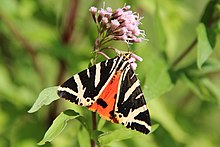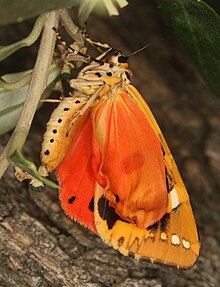Loading AI tools
Species of moth From Wikipedia, the free encyclopedia
Euplagia quadripunctaria, the Jersey tiger, or Spanish flag, is a diurnal moth of the family Erebidae. The species was first described by Nikolaus Poda von Neuhaus in 1761. The adult wingspan is 52–65 millimetres (2.0–2.6 in), and they fly from July to September, depending on the location.[1] They tend to fly close to Eupatorium cannabinum.[2]
| Jersey tiger | |
|---|---|
 | |
 | |
| Scientific classification | |
| Domain: | Eukaryota |
| Kingdom: | Animalia |
| Phylum: | Arthropoda |
| Class: | Insecta |
| Order: | Lepidoptera |
| Superfamily: | Noctuoidea |
| Family: | Erebidae |
| Subfamily: | Arctiinae |
| Genus: | Euplagia |
| Species: | E. quadripunctaria |
| Binomial name | |
| Euplagia quadripunctaria (Poda, 1761) | |
| Synonyms | |
| |
The larvae (caterpillars) are polyphagous, feeding from September to May on nettles (Urtica), raspberries (Rubus),[3] dandelion (Taraxacum), white deadnettle (Lamium), ground ivy (Glechoma), groundsel (Senecio), plantain (Plantago), borage (Borago), lettuce (Lactuca),[4] and hemp-agrimony (Eupratoria).[1] The insect overwinters as a small larva.[1]
Large groups of adults of subspecies E. q. rhodosensis can be found on occasion aestivating (sheltering from the summer heat) in Petaloudes, on Rhodes, in a place that has become known as the Valley of the Butterflies.[5]
Euplagia quadripunctaria is widely distributed in Europe from Estonia and Latvia in the north to the Mediterranean coast and islands in the south.[4] It is also found in western Russia, the southern Urals, Asia Minor, Rhodes and nearby islands, the Near East, Caucasus, southern Turkmenistan, and Iran.[6] Individuals are known to migrate northwards from their regular breeding grounds during the summer.[1]
Aside from being frequent in the Channel Islands (whence its common name comes), this species was rarely seen in the British Isles in Victorian times.[4] It was described by William Forsell Kirby as, "a great rarity in the South of England, except one locality in Devonshire."[3] Since then however it has spread more widely in Devon and Cornwall,[1] and has recently been seen more frequently in southern England, especially on the Isle of Wight, in northern Kent,[7] and south London.[8] They have been seen regularly and in numbers every year in London first discovered at Devonshire Road Nature Reserve in Forest Hill since 2004, so it is probable that they have established a breeding colony.[9]
Mothrecording.org shows a string of connected sightings on the South Kent coast from Dover to Rye in the first two decades of the twenty-first century. These are disconnected from the block of sightings in South-West England and so probably came from the Continent directly.
This is the only lepidopteran which has been designated as a 'priority species' under Annex II of the Habitats Directive in the European Union, as of 1992,[10] which means areas in which it occurs can be declared Special Areas of Conservation.
Seamless Wikipedia browsing. On steroids.
Every time you click a link to Wikipedia, Wiktionary or Wikiquote in your browser's search results, it will show the modern Wikiwand interface.
Wikiwand extension is a five stars, simple, with minimum permission required to keep your browsing private, safe and transparent.